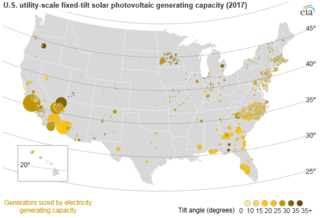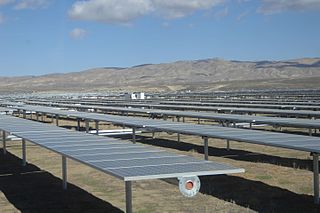Many nations have installed significant solar power capacity into their electrical grids to supplement or provide an alternative to conventional energy sources. Solar power plants use one of two technologies:

Spain is one of the top ten countries by solar photovoltaics installed capacity and the first country for concentrated solar power (CSP) in the world. In 2016, the cumulative total solar power installed was 6,969 MW, of which 4,669 MW were solar PV installations and 2,300 MW were concentrated solar power. In 2016, nearly 8 TWh of electrical power was produced from photovoltaics, and 5 TWh from CSP plants. During 2016 Photovoltaics accounted for 3% of total electricity generation and solar thermal an additional 1.9%.

The Nellis Solar Power Plant is a 14-megawatt (MW) photovoltaic power station located within Nellis Air Force Base in Clark County, Nevada, northeast of Las Vegas. The power plant was inaugurated in a ceremony on December 17, 2007, with Nevada Governor Jim Gibbons activating its full operation. On average, it has since generated 32 gigawatt-hours of electricity annually and supplied more than 25% of the power used at the base.

The Erlasee Solar Park, or Solarstrompark Gut Erlasee, is an 11.4 megawatt (MW) photovoltaic power station located in Bavaria, southern Germany, in one of the sunniest regions of the country. Constructed on a former vineyard by the company Solon SE in 2006, it was then the world's largest photovoltaic power station.
Guadarranque solar power plant is a photovoltaic solar power plant in the Guadarranque industrial park in San Roque, Cádiz, Spain. The plant is owned and operated by Endesa.

Solar power in the United States includes utility-scale solar power plants as well as local distributed generation, mostly from rooftop photovoltaics. As of the end of 2017, the United States had over 50 gigawatts (GW) of installed photovoltaic capacity. In the twelve months through December 2018, utility scale solar power generated 66.6 terawatt-hours (TWh), 1.66% of total U.S. electricity. During the same time period total solar generation, including estimated small scale Generation photovoltaic generation, was 96.1 TWh, 2.30% of total U.S. electricity. In terms of total cumulative installed capacity, by year end 2017 the United States ranked 2nd in the world behind China. In 2016, 39% of all new electricity generation capacity in the country came from solar, more than any other source and ahead of natural gas (29%). By 2015, solar employment had overtaken oil and gas as well as coal employment in the United States. In 2016, more than 260,000 Americans were employed in the solar industry.

The renewable-energy industry is the part of the energy industry focusing on new and appropriate renewable energy technologies. Investors worldwide have paid greater attention to this emerging industry in recent years. In many cases, this has translated into rapid renewable energy commercialization and considerable industry expansion. The wind power and solar photovoltaics (PV) industries provide good examples of this.

Topaz Solar Farm is a 550 megawatt (MWAC) photovoltaic power station in San Luis Obispo County, California. Construction on the project began in November 2011 and ended in November 2014. It is one of the world's largest solar farms. The $2.5 billion project includes 9 million CdTe photovoltaic modules based on thin-film technology, manufactured by U.S. company First Solar. The company also built, operates and maintains the project for MidAmerican Renewables, a Berkshire Hathaway company. Pacific Gas and Electric will buy the electricity under a 25-year power purchase agreement. According to First Solar, it created about 400 construction jobs.

The California Valley Solar Ranch (CVSR) is a 250 megawatt (MWAC) photovoltaic power plant in the Carrizo Plain, northeast of California Valley. The project is owned by NRG Energy, and SunPower is the EPC contractor and technology provider. The project constructed on 1,966 acres (796 ha) of a 4,365-acre (1,766 ha) site of former grazing land. It is utilizing high-efficiency, crystalline PV panels designed and manufactured by SunPower. The project includes up to 88,000 SunPower solar tracking devices to hold PV panels that will track the sun across the sky.
Covaci Solar Park, which will be one of the world's largest thin-film photovoltaic (PV) power systems, is being built on a 60-hectare (148-acre) plot of land to the north of Timişoara in Romania. The power plant will be a 35-megawatt solar power system using state-of-the-art thin-film technology, and was to be finished by the end of 2011. A total of 480,000 First Solar thin-film modules will be used, and will supply 35,000 MWh of electricity per year.

The DeSoto Next Generation Solar Energy Center is a photovoltaic power station in Arcadia, DeSoto County, in the U.S. state of Florida, owned by Florida Power & Light (FPL). President Barack Obama attended the plant's commissioning on October 27, 2009. It has a nameplate capacity of 25 megawatts (MW), and produces an estimated 42,000 megawatt hours (MW·h) of electricity per year.
The Blythe Mesa Solar Power Project, also known as the Blythe Solar Energy Center, is a 235 megawatt (MWAC) photovoltaic power plant near the city of Blythe in Riverside County, California. It occupies about 2,000 acres of public land managed by the Bureau of Land Management in the Mojave Desert. The construction uses CdTe thin film panels from the U.S. firm First Solar, and the majority of the output is being sold to Kaiser Permanente and Southern California Edison under 20-year power purchase agreements.

Development of solar power in Greece started in 2006 and installations of photovoltaic systems skyrocketed from 2009 because of the appealing feed-in tariffs introduced and the corresponding regulations for domestic applications of rooftop solar PV. However, this mechanism overheated the market creating a big deficit of more than 500 million euros in the Greek "Operator of Electricity Market". Because that boom in the market couldn't be sustained, since August 2012, new regulations have been introduced including retrospective feed-in tariffs reduction, with further reductions over time.

The Copper Mountain Solar Facility is a 552 megawatt (MWAC) solar photovoltaic power plant in Boulder City, Nevada developed by Sempra Generation. It uses approximately 9 million cadmium telluride modules made by the US thin-film manufacturer First Solar. When the first unit of the facility entered service on December 1, 2010, it was the largest photovoltaic plant in the U.S. at 58 MW. It is co-located with the 64 MW Nevada Solar One and 150 MW Boulder Solar projects in the Eldorado Valley, thus forming a more than 750 MW solar generating complex. By comparison, generating capacity at the nearby Hoover Dam is about 2,000 MW.
Târgu Jiu Solar Park, a large thin-film photovoltaic (PV) power system, is being built on a 10 ha plot of land near the Târgu Jiu city in Romania. The power plant will be a 4-megawatt solar power system using state-of-the-art thin film technology, and should be finished by the end of 2012. The solar park is expected to supply 2,000 MWh of electricity per year.
The Mesquite Solar project is a 400-megawatt (MWAC) photovoltaic power plant in Arlington, Maricopa County, Arizona, owned by Sempra Generation. The project was constructed in 3 phases using more than 2.1 million crystalline silicon solar panels made by Suntech Power. Future expansion phases may increase the capacity to 700 MWAC over 16.2 square kilometers making it among the world's largest PV power stations.

Solar power in Florida has been increasing, as the cost of solar power systems using photovoltaics (PV) has decreased in recent years. Florida has low electricity costs compared with other states, which makes individual solar investment less attractive. Florida ranks ninth nationally in solar resource strength according to the National Renewable Energy Laboratory and tenth in solar generation by the Solar Energy Industries Association.
Northern Chile has the highest solar incidence in the world. In October 2015 Chile's Ministry of Energy announced its "Roadmap to 2050: A Sustainable and Inclusive Strategy", which plans for 19% of the country's electricity to be from solar energy, 23% wind power and 29% hydroelectric power.
Mount Signal Solar, also known as Imperial Valley Solar Project, is a 594 MWp (460 MWAC) photovoltaic power station west of Calexico, California in the southern Imperial Valley, near the Mexican border. The facility is being developed and constructed by 8minutenergy Renewables in three phases, with two completed as of 2018. At full build-out, it will be one of the world's largest PV solar farms with a capacity of about 800 MWp (600 MWAC). The project has been supported by several environmental groups, as the power station was built on low productivity farmland.













